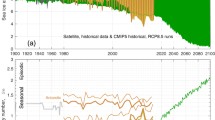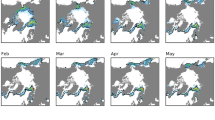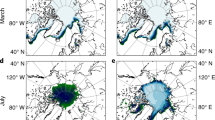Abstract
Simulations of the Arctic sea ice cover over the last 32 years generated by the HadGEM1 coupled climate model are able to capture the observed long term decline in mean September ice extent. HadGEM1 is also capable of producing an episode of low September ice extent of similar magnitude to the anomalously low extent observed in 2007. Using a heat budget analysis, together with diagnostics partitioning the changes in ice and snow mass into thermodynamic and dynamic components, we analyse the factors driving the long term decline in the ice mass and extent as well as those causing the modelled low ice event. The long term decline in the mass of ice and snow in HadGEM1 is largely due to extra melting during the summer, partly at the top surface of the ice, and partly via extra heating from the ocean as it warms due to the ice retreat. The episode of low summer ice extent is largely driven by the synoptic conditions over the summer moving the ice across and out of the Arctic basin, and also due to pre-conditioning of the snow and ice which is thinner than usual in the Eastern Arctic at the start of the melt season. This case study demonstrates that although HadGEM1 does not capture the persistent dipole pressure anomaly observed during the summer of 2007, it represents broadly similar mechanisms of generating a low ice extent.














Similar content being viewed by others
Notes
Meier et al. (2007) noted a significant inconsistency in the original version of HadISST due to a change in the satellite data product in 1996/1997. The version of HadISST (vn1.2) presented here has had this inconsistency corrected (Titchner and Rayner, pers. com. 2009).
References
Alexander MA, Bhatt US, Walsh JE, Timlin MS, Miller JS, Scott JD (2004) The atmospheric response to realistic Arctic sea ice anomalies in an AGCM during winter. J Clim 17:890–905. doi:10.1175/1520-0442
Banks HT, Stark S, Keen AB (2007) The adjustment of the coupled climate model HadGEM1 toward equilibrium and the impact on global climate. J Clim 20:5815–5826. doi:10.1175/2007JCLI1688.1
Bitz CM, Roe GH (2004) A Mechanism for the high rate of sea ice thinning in the Arctic Ocean. J Clim 17:3623–3632. doi:10.1175/1520-0442
Curry JA, Schramm JL, Perovich DK, Pinto JO (2001) Applications of SHEBA/FIRE data to evaluation of snow/ice albedo parameterizations. J Geophys Res 106:D14. doi:10.1029/2000JD900311
Deser C, Magnusdottir G, Saravanan R, Phillips A (2004) The effects of North Atlantic SST and sea ice anomalies on the winter circulation in CCM3. Part II: direct and indirect components of the response. J Clim 17:877–889
Deser C, Thomas RA, Peng S (2007) The transient atmospheric circulation response to North Atlantic SST and sea ice anomalies. J Clim 20:4751–4767
Fichefet T, Morales Maqueda MA (1997) Sensitivity of a global sea ice model to the treatment of ice thermodynamics and dynamics. J Geophys Res 102(C6):12609–12646. doi:10.1029/97JC00480
Francis JA, Chan W, Leathers DJ, Miller JR, Veron DE (2009) Winter Northern Hemisphere weather patterns remember summer Arctic sea ice extent. Geophys Res Lett 36:L07503. doi:10.1029/2009GL037274
Graversen RG, Mauritsen T, Drijfhout S, Tjernström M, Mårtensson S (2011) Warm winds from the Pacific caused extensive Arctic sea-ice melt in summer 2007. Clim Dyn 36:2103–2112. doi:10.1007/s00382-010-0809
Guemas V, Salas-Melia D (2008) Simulation of the Atlantic meridional overturning circulation in an atmosphere-ocean global coupled model. Part II: weakening in a climate change experiment: a feedback mechanism. Clim Dyn 30:831–844. doi:10.1007/s00382-007-0328-8
Hibler WD (1979) A dynamical thermodynamic sea ice model. J Phys Oceanogr 9:815–846
Holland MM, Bitz CM, Eby M, Weaver AJ (2001) The role of ice–ocean interactions in the variability of the North Atlantic thermohaline circulation. J Clim 14(5):656–675. doi:10.1175/1520-0442(2001)014<0656:TROIOI>2.0.CO;2
Holland MM, Serreze MC, Stroeve J (2010) The sea ice mass budget of the Arctic and it’s future change as simulated by coupled climate models. Clim Dyn 34:185–200. doi:10.1007/s00382-008-0493-4
Holland MM, Bailey DA, Vavrus S (2011) Inherent sea ice predictability in the rapidly changing Arctic environment of the community climate system model, version 3. Clim Dyn 36(7–8):1239–1253. doi:10.1007/s00382-010-0792-4
Hunke EC, Dukowicz JK (1997) An elastic-viscous-plastic model for sea ice dynamics. J Phys Oceanogr 27:1849–1867. doi:10.1175/1520-0485(1997)027<1849:AEVPMF>2.0.CO;2
Hunke EC, Lipscomb WH (2004) CICE: the Los Alamos sea ice model, documentation and software, version 3.1, LA-CC-98-16, Los Alamos Natl. Lab., Los Alamos, N. M
Johns TC et al (2006) The new Hadley Centre climate model (HadGEM1): evaluation of coupled simulations. J Clim 19:1327–1353. doi:10.1175/JCLI3712.1
Jones GS, Christidis N, Stott PA (2011) Detecting the influence of fossil fuel and bio-fuel black carbon aerosols on near surface temperature changes. Atmos Chem Phys 11:799–816. doi:10.5194/acp-11-799-2011
Kauker F, Kaminski T, Karcher M, Giering R, Gerdes R, Voßbeck M (2009) Adjoint analysis of the 2007 all time Arctic sea-ice minimum. Geophys Res Lett 36:L03707. doi:10.1029/2008GL036323
Kwok R (2008) Summer sea ice motion from the 18 GHz channel of AMSR-E and the exchange of sea ice between the Pacific and Atlantic sectors. Geophys Res Lett 35:L03504. doi:10.1029/2007GL032692
L’Heureux ML, Kumar A, Bell GD, Halpert MS, Higgins RW (2008) Role of the Pacific-North American (PNA) pattern in the 2007 Arctic sea ice decline. Geophys Res Lett 35:L20701. doi:10.1029/2008GL035205
Lindsay RW, Zhang J (2005) The thinning of Arctic sea ice, 1988–2003: have we passed a tipping point? J Clim 18:4879–4894. doi:http://dx.doi.org/10.1175/JCLI3587.1
Lindsay RW, Zhang J, Schweiger A, Steele M, Stern H (2009). Arctic sea ice retreat in 2007 follows thinning trend. J Clim 22(1):165–176. doi:10.1175/2008JCLI2521.1
Lipscomb WH (2001) Remapping the thickness distribution in sea ice models. J Geophys Res 106:13989–14000. doi:10.1029/2000JC000518
Magnusdottir G, Deser C, Saravanan R (2004) The effects of North Atlantic SST and sea-ice anomalies on the winter circulation in CCM3. Part I: main features and storm-track characteristics of the response. J Clim 17:857–876
Maslanik J, Drobot S, Fowler C, Emery W, Barry R (2007a) On the Arctic climate paradox and the continuing role of atmospheric circulation in affecting sea ice conditions. Geophys Res Lett 34(3):Article Number: L03711. doi:10.1029/2006GL028269. Published: FEB 13 2007
Maslanik J, Fowler C, Stroeve J, Drobot S, Zwally J, Yi D, Emery W (2007b) A younger, thinner Arctic ice cover: increased potential for rapid, extensive sea-ice loss. Geophys Res Lett 34(24):Article Number: L24501. doi:10.1029/2007GL032043
McLaren AJ, Banks HT, Durman CF, Gregory JM, Johns TC, Keen AB, Ridley JK, Roberts MJ, Lipscomb WH, Connolley WM, Laxon SW (2006) Evaluation of the sea ice simulation in a new coupled atmosphere-ocean climate model (HadGEM1). J Geophys Res 111(C12):Article Number: C12014. doi:10.1029/2005JC003033
McPhee MG (1992) Turbulent heat flux in the upper ocean under sea ice. J Geophys Res 97(C4):5365–5379. doi:10.1029/92JC00239
Meier W, Stroeve J, Fetterer F (2007) Whither Arctic sea ice? A clear signal of decline regionally, seasonally and extending beyond the satellite record. Ann Glaciol 46:428–434. doi:10.3189/172756407782871170
Nakićenović N, Swart R (eds) (2000) Special report on emissions scenarios. A special report of working group III of the intergovernmental panel on climate change. Cambridge University Press, Cambridge
Notz D (2009) The future of ice sheets and sea ice: between reversible retreat and unstoppable loss. Proc Natl Acad Sci 106(49):20590–20595. doi:10.1073/pnas.0902356106
Ogi M, Rigor IG, McPhee MG, Wallace JM (2008) Summer retreat of Arctic sea ice: role of summer winds. Geophys Res Lett 35:L24701. doi:10.1029/2008GL035672
Overland JE (2011) Potential Arctic change through climate amplification processes. Oceanography 24:176–185
Overland J, Wang M (2010) Large-scale atmospheric circulation changes are associated with the recent loss of Arctic sea ice. Tellus A 62:1–9. doi:10.1111/j.1600-0870.2009.00421.x
Overland JE, Wang M, Salo S (2008) The recent Arctic warm period. Tellus A 60:589–597. doi:10.1111/j.1600-0870.2008.00327.x
Perovich DK (2011) The changing arctic sea ice cover. Oceanography 24:162–173
Perovich DK, Grenfell TC, Richter-Menge JA, Light B, Tucker III WB, Eicken H (2003) Thin and thinner: sea ice mass balance measurements during SHEBA. J Geophys Res 108(C3):8050. doi:10.1029/2001JC001079
Perovich DK, Light B, Eicken H, Jones KF, Runciman K, Nghiem SV (2007) Increasing solar heating of the Arctic Ocean and adjacent seas, 1979–2005: attribution and role in the ice-albedo feedback. Geophys Res Lett 34:L19505. doi:10.1029/2007GL031480
Perovich DK, Richter-Menge JA, Jones KF, Light B (2008) Sunlight, water, and ice: extreme Arctic sea ice melt during the summer of 2007. Geophys Res Lett 35:L11501. doi:10.1029/2008GL034007
Petoukhov V, Semenov VA (2010) A link between reduced Barents-Kara sea ice and cold winter extremes over northern continents. J Geophys Res 115. doi:10.1029/2009JD013568
Polyakov IV et al (2005) One more step toward a warmer Arctic. Geophys Res Lett 32:L17605. doi:10.1029/2005GL023740
Rayner NA, Parker DE, Horton EB, Folland CK, Alexander LV, Rowell DP, Kent EC, Kaplan A (2003) Global analyses of sea surface temperature, sea ice, and night marine air temperature since the late nineteenth century. J Geophys Res 108(D14). doi:10.1029/2002JD002670
Schweiger A, Lindsay R, Zhang J, Steele M, Stern H, Kwok R (2011) Uncertainty in modeled Arctic sea ice volume. J. Geophys Res 116:C00D06. doi:10.1029/2011JC007084
Sedlacek J, Knutti R, Martius O, Beyerle U (2011) Impact of a reduced Arctic sea-ice cover on ocean and atmospheric properties. J Clim. doi:10.1175/2011JCLI3904.1
Semtner AJ (1976) A model for the thermodynamic growth of sea ice in numerical investigations of climate. J Phys Oceanogr 6:379–389. doi:10.1175/1520-0485
Semtner AJ (1984) On modelling the seasonal thermodynamic cycle of sea ice in studies of climatic change. Climatic Change 6:27–37
Serreze MC, Barrett AP, Slater AG, Steele M, Zhang J, Trenberth KE (2007) The large-scale energy budget of the Arctic. J Geophys Res 112:D11122. doi:10.1029/2006JD008230
Shimada K, Kamoshida T, Itoh M, Nishino S, Carmack E, McLaughlin F, Zimmermann S, Proshutinsky A (2006) Pacific Ocean inflow: influence on catastrophic reduction of sea ice cover in the Arctic Ocean. Geophys Res Lett 33:L08605. doi:10.1029/2005GL025624
Steele M, Zhang J, Ermold W (2010) Mechanisms of summertime upper Arctic Ocean warming and the effect on sea ice melt. J Geophys Res 115:C11004. doi:10.1029/2009JC005849
Stott PA, Jones GS, Lowe JA, Thorne P, Durman C, Johns TC, Thelen J-C (2006) Transient climate simulations with the HadGEM1 climate model: causes of past warming and future climate change. J Clim 19:2763–2782. doi:10.1175/JCLI3731.1
Stroeve J, Holland MM, Meier W, Scambos T, Serreze M (2007) Arctic sea ice decline: faster than forecast. Geophys Res Lett 34:L09501. doi:10.1029/2007GL029703
Stroeve J, Serreze M, Drobot S, Gearheard S, Holland M, Maslink J, Meier W, Scambos T (2008) Arctic sea ice extent plummets in 2007. EOS Trans 89(2):13–14
Stroeve JC, Serreze MC, Kay JE, Holland MM, Meier WN, Barrett AP (2012) The Arctic’s rapidly shrinking sea ice cover: a research synthesis. Climatic Change 110:1005–1027. doi:10.1007/s10584-011-0101-1
Strong C, Magnusdottir G, Stern H (2009) Observed feedback between winter sea ice and the North Atlantic Oscillation. J Clim 22:6021–6032. doi:10.1175/2009JCLI3100.1
Thorndike AS, Rothrock DA, Maykut GA, Colony R (1975) The thickness distribution of sea ice. J Geophys Res 80(33):4501–4513
Tucker WB III, Gow AJ, Weeks WF (1987) Physical properties of summer sea ice in the fram strait. J Geophys Res 92:C7. doi:10.1029/JC092iC07p06787
Vancoppenolle M, Fichefet T, Bitz CM (2005) On the sensitivity of undeformed Arctic sea ice to its vertical salinity profile. Geophys Res Lett 32:L16502. doi:10.1029/2005GL023427
Wang M, Overland JE (2009) A sea ice free summer Arctic within 30 years? Geophys Res Lett 36:L07502. doi:10.1029/2009GL037820
Wang J, Zhang J, Watanabe E, Ikeda M, Mizobata K, Walsh JE, Bai X, Wu B (2009) Is the Dipole Anomaly a major driver to record lows in Arctic summer sea ice extent? Geophys Res Lett 36:L05706. doi:10.1029/2008GL036706
West AE, Keen AB, Hewitt HT (2013) Mechanisms causing reduced Arctic sea ice loss in a coupled climate model, submitted to the Cryosphere
Wu Q, Zhang X (2010) Observed forcing feedback processes between Northern Hemisphere atmospheric circulation and Arctic sea ice coverage. J Geophys Res 115:D14119. doi:10.1029/2009JD013574
Acknowledgments
This work was supported by the UK Department of Energy and Climate Change (DECC) and the Department for Environment, Food and Rural Affairs (Defra), through the DECC/Defra Met Office Hadley Centre Climate Programme (GA01101). We thank two anonymous reviewers for their useful comments and suggestions to improve the manuscript.
Author information
Authors and Affiliations
Corresponding author
Rights and permissions
About this article
Cite this article
Keen, A.B., Hewitt, H.T. & Ridley, J.K. A case study of a modelled episode of low Arctic sea ice. Clim Dyn 41, 1229–1244 (2013). https://doi.org/10.1007/s00382-013-1679-y
Received:
Accepted:
Published:
Issue Date:
DOI: https://doi.org/10.1007/s00382-013-1679-y




